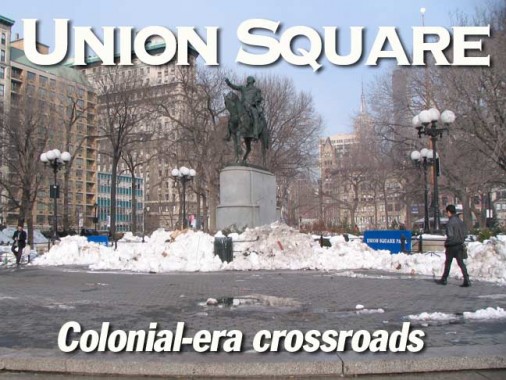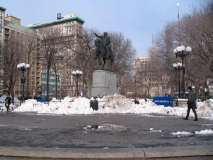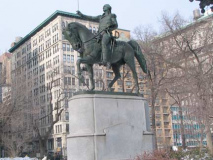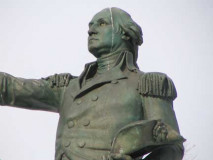Union Square was named (actually as Union Place) in 1815 at the near-junction of the Bloomingdale Road, or Post Road to Albany, and the northern part of the Bowery Road, the Post Road to Boston. In the original Commissioners’ Plan drawn up 1807-1811 by surveyor John Randel, Broadway was originally going to run “north” above Tenth Street and end at a 239-acre military training ground called The Parade spanning between 3rd to 7th Avenues and from 23rd to 34th Streets. By 1814, however, the idea for The Parade had been scrapped as the new Third Avenue diminished the Post Road’s importance, and emphasis was then placed on Broadway as a main north-south route up Manhattan Island. To do that, it took a northwest angle.

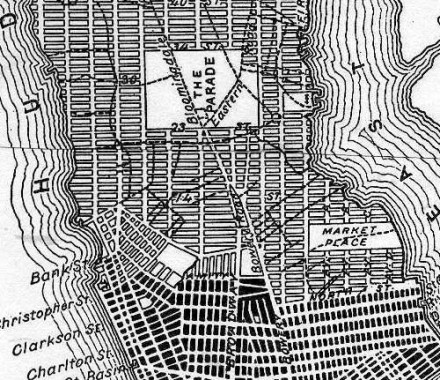
By 1839 Bloomingdale Road was renamed Broadway all the way to what became Columbus Circle, and then Broadway a few decades later all the way to the Harlem River and beyond. And, by the late 1850s, The Parade was finally replaced by Central Park, and the Post Road was gradually closed in sections north of 14th Street beginning in the 1830s, to resume in the Bronx.
Union Place, the meeting of the Bloomingdale and Bowery Roads, was so named by 1815, but served time as a potter’s field and a place for squatters until the park’s present configuration west of 4th Avenue (Union Square East), Union Square West (Broadway) East 14th Street and East 17th was finally laid out and landscaped as the modern street grid had reached that far uptown by then. After a short stint as Union Park, the name Union Square was settled on by the 1870s. The square is named for the junction of roads, not the Union (USA, vs the Confederacy) or later gatherings by trade unions that took place there.
In the mid-1800s, Union Square was actually the home of NYC’s entertainment district, that had crept north along the Bowery since the post-colonial era. The story of Union Square’s nightlife era is best told in Luc Sante’s excellent book Low-Life. In 1856, the first of Union Square’s well-known landmarks first appeared.
Henry Kirke Brown’s bronze mounted statue of George Washington was NYC’s first major outdoor portrait statue. It was just the second mounted statue produced in the USA, following Clark Mills’ Andrew Jackson in Washington, DC. This Washington portrays his reclamation of NYC from the British after their surrender in 1783, which was supposed to have taken place in the vicinity of where University Place meets 14th Street today. It was first set up in the middle of the intersection, protected from what was then mounted and wagon traffic by a fence, but it was moved soon enough to its current location facing East 14th. The statue does go against mounted statuary tradition in that one horse’s leg raised usually indicates the rider died from wounds suffered on the battlefield; Washington died at Mount Vernon on 12/14/1799.
At the southern edge of Union Square stands a flock of castiron lamps that had drifted under my radar for several years. Their pedigree is the “Brighter Brooklyn” posts installed in that borough in the early 1900s. Gradually they had disappeared over the decades until only three were left. The city shipped one of them to the Spring City lighting company, which produced several reproductions that were installed in Union Square during the latest of several renovations in the late 1990s.
Union Square accumulated some of the city’s most distinctive architecture beginning in the post-Civil War period. The building shown here on the right is actually the oldest of the three in the picture!
On the left is the Romanesque Lincoln Building, on the corner of Union Square West and East 14th (that sounds impossible, but that’s how they name streets here…) It was designated a NYC Landmark in 1988, and was designed by architect R. H. Robertson 99 years before that. The buildings surrounding Union Square were designed at the dawn of the skyscraper era.
In the center is the Spingler Building, architects William H. Hume and Son, 1897. It originally contained stores, showrooms, manufacturers and industrial lofts. Note the tripartite style, an architectural sandwich: two floors with wide windows at the bottom, yellow-bricked center, and attic floor and cornice. The name harkens back to the Spingler House, a hotel formerly in the locale — a Henry Spingler owned much of the land here in the colonial era.
“Henry Spingler was a market gardner. He lived at the end of the eighteenth century on the Bowery, at the corner of that thoroughfare and Broadway, now Fifteenth Street and Union Square, and owned a vast tract of land that now is covered with splendid business buildings. The house was a quaintly built Dutch structure. It was said that he had inherited the house and lands, or, rather, acquired them, from being the steward of another man, who had given them into his keeping and who had gone to Europe and never returned. He was, however, shrewd and industrious, and improved and increased the estate. He died in 1814 and left two children, one of whom married Lieut. James Fonerden, son of the famous Baltimore Abolitionist. The daughter of this union was Mary Spingler Fonerden. She married Michael Murray Van Buren. It was a love match. The young man had been a mechanic. They removed in 1833 to a house built on the site of the present one [21 W. 14th St.] which stands in the centre of the Spingler estate, the boundaries extending to Seventh Avenue on one side, and to Union Square on the other.” from Walter Grutchfield, 14 to 42
The building on the right in the modern photo – the one that looks like metal and glass boxes stacked together — is the oldest of the group and was originally built in 1870 as the first Tiffany jewelry store in NYC. John Kellum designed what was at first an elaborate cast-iron fronted building. The Times called the new building a “palace of jewels,” with black-walnut counters and ebony cases holding watches, fans, opera glasses and other articles in wood, leather, silver, cloisonné, enamel, bronze and rosewood. NY Times, July 2, 2006
Tiffany moved uptown in 1906. NYPL archives
After a stint as a garment company wholesaler and then headquarters of the Amalgamated Bank, the castiron exterior began to crumble, prompting the owners to strip it off and encase the building in bland white brick in 1953. That’s how it stood until 2008 when condo developer Brack Capital and architect Eran Chen encased it in the glass and metal boxes you see there today; it is now known as 15 Union Square West.
By coincidence, Union Square’s “union” can also apply to the junction of three separate major subway trunk lines, the IRT Lexington (4, 5, 6), the BMT Broadway (R, Q, N) and the BMT Canarsie (L). In one of Union Square’s waves of renovation, unique station entrance canopies that are found nowhere else in the system were installed, in addition to decorative newsstand kiosks (though this one may be threatened by the new CEMUSA newsstands being installed all over town. There is also a boxy subway entrance indicator lamp stanchion.
The Daniel Willis James Temperance Fountain facing West 15th and Union Sq West was cast in 1881 by sculptor Karl Adolph Donndorf and depicts a female figure representing Charity holding a baby and offering a drink to her young son. The figures were modeled after the sculptor’s wife and children.
“Temperance fountains” offering free drinks of water were in vogue in the late 19th Century to promote health, cleanliness and of course, abstinence from alcohol. They were the brainchild of James, who headed the Phelps, Dodge mining company, and Theodore Roosevelt, then a NY State Assemblyman. James funded the fountain.
Originally water issued form the 4 lions’ heads and tin drinking cups hung from chains alongside. In photo left taken from the Stephen Jenkins book refered to above, the fountain was in the triangle at Union Square West and East 14th in 1897.
I wasn’t able to get close to the Charles F. Murphy Memorial Flagpole because of snow accumulation and the closure of the lawn for seeding. A better closeup photo can be found on this flickr page. The bronze bas-reliefs by sculptor Anthony De Francisci (sculptor of the Peace Silver Dollar in use from 1921-1935) depict the Declaration of Independence and its signatures; the effects of tyranny; the effects of liberty; and emblems of the USA’s first thirteen colonies.
The flagpole and its base were the gifts of the Tammany Society and at first honored Murphy, a former Tammany boss. It was also nicknamed the Independence Flagstaff as some public sentiment was against honoring a Tammany chieftain.
I don’t know much about the 1950s or 1960s office building it’s in, but The Coffee Shop has been a mainstay at Union Square and East 16th for over 20 years, even before it was cleaned up and was a main headquarters for drug dealers.
There must have been an earlier iteration, though, since its neon sign seems much older than that.
The buildings on the NW corner of Union Square West and East 16th Street also date from the dawn of the skyscraper era. At left is the slivery 1903 Bank of the Metropolis Building (Bruce Price, architect) that is actually wider on the 16th Street side. The bank was founded in 1871 and was absorbed by the Bank of Manhattan in 1908, just 5 years after the building opened.
Immediately to the right is the Decker Building, completed in 1893 by architect John Edelmann, an associate of Louis Sullivan. The Moorish-style building was the home of the Decker Piano Company when it opened, replacing an earlier Decker Piano building. This was home to the second location of Andy Warhol‘s Factory between 1968-1974; it was here that a disturbed Valerie Solanas shot and wounded Warhol June 3, 1968 — she thought he had stolen a screenplay of hers.
Moving to East 17th on the north side of Union Square, the building on the left, corner Broadway, was home to Warhol’s last Factory from 1974-1987. Two doors down is the red brick Queen Anne-style Century Building (1881, architect William Schickel) originally home to The Century Magazine and St. Nicholas Magazine for children (which, oddly enough, I remember from seeing reprints of it in the library as a kid). For almost 20 years it has been home to a branch of Barnes and Noble booksellers, and continues in that role as of January 2011; other B&Ns around town have fallen victim to rising rents and new electronic transfer of books.
Union Square’s north end limestone arch, flanked by two Ionic-columned pavilions, was built in 1929. Though the south end of the park is now where most demonstrations take place these days, the pavilion has historically been the site for marches, sit-ins and protests through the years. Plans are afoot to make the pavilion the centerpiece for anupscale restaurant. A new playground opened adjacent to it in 2009.
Just as a Henry Kirke Brown bronze of George Washington dominates the south end of the park does a Brown Lincoln bestride the north end. This was the first statue of Lincoln to appear in NYC after his assassination in Washington in 1865, as it was installed in Union Square three years later. A similar Lincoln statue also sculpted by Brown is in the Picnic Grove in Prospect Park in Brooklyn.
At Union Square’s northeast end, East 17th and Union Square East, is the last version of Tammany Hall, constructed in 1928. Tammany Hall was an organization associated with the Democratic Party that dominated NYC politics for about a century, from the 1830s through the 1930s. The name was a bowdlerization of the name of a (likely fictional) Indian chief. A film school, New York Film Academy, now occupies much of the building. On East 16th, a wide painted ad advertises Crown Coat Fronts (out of the picture to the right, a smaller sign says ” Mftr’s of Civilian and Military Coat Fronts.” According to Walter Grutchfield, the company was here between 1947 and 1958. “Coat fronts” were a”trade term for a built-up stiffening or shape-retaining interlining for the fronts of coats, made of stitched layers of haircloth, felt and canvas.”
Look closely at the left side of the Crown ad, and you can see that the paint has worn off sufficiently to allow a glimpse of the painted ad that preceded it, for Hyman and Oppenheim Human Hair Goods.
Frédéric-Auguste Bartholdi’s Marquis de Lafayette faces Union Square East and East 15th was dedicated in 1876, the USA Centennial. He was a staunch ally of the USA and became a close friend of George Washington, and his aid enabled the USA to win several crucial battles, most notably the Battle of Yorktown. France wavered in its support of the USA after the Revolution, but Lafayette continued on as a legendary and revered figure in the USA. He returned for a triumphal visit in 1824. If you are familiar with the name Bartholdi, you know that Liberty Enlightening The World, the Statue of Liberty, was also a Bartholdi work ten years later, in 1886.
Corinthian-columned, monumental Union Square Savings Bank, Union Square East and East 15th, was built in 1905 as a mini-Greek temple worshiping thrift. Its architect wasHenry Bacon of the Lincoln Memorial and thousands of NYC park lampposts.
Photographed December 31, 2010; page completed January 4, 2011
